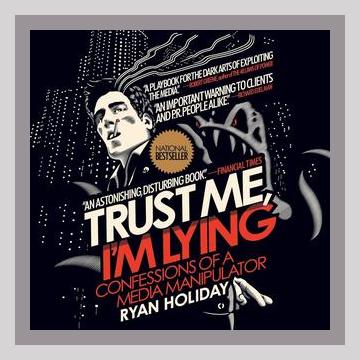Marketing and SalesDigital Marketing
Introduction
“Trust Me, I’m Lying: Confessions of a Media Manipulator” by Ryan Holiday is a revelation of the dark underbelly of the digital media landscape. Holiday, a seasoned marketer and media strategist, dissects how blogs and online publishers can be manipulated to shape public perception and drive narratives. The book is divided into two major sections: “Feeding the Monster” and “The Monsters’ Quid Pro Quo.”
Section 1: Feeding the Monster
1. The Economics of Misinformation
Holiday explains how the blogosphere is driven by advertising revenue. Bloggers are incentivized to generate high traffic over factual reporting because economic rewards are tied to clicks and page views.
- Example: Holiday refers to his experience at American Apparel, where he would plant fake stories on blogs to ignite controversy and, subsequently, media coverage.
- Actionable Tip: To leverage this, create sensational news hooks that are likely to attract reader attention and generate viral content.
2. Manipulating the Bloggers
Holiday dives into the tactics used to manipulate bloggers, including feeding them exaggerated or false information to get coverage.
- Example: He mentions orchestrating a fake protest against American Apparel in order to garner media attention, knowing that blogs would amplify the controversy.
- Actionable Tip: Send anonymous tips or press releases with exaggerated claims to bloggers to steer their coverage according to your agenda.
3. Trading Up the Chain
The concept of “trading up the chain” involves planting a story in smaller blogs with the aim of having it picked up by more significant media outlets, thereby amplifying its reach.
- Example: Holiday describes how stories started in minor blogs eventually made it to the pages of major newspapers like The New York Times.
- Actionable Tip: Start by targeting small, niche blogs that larger outlets monitor for trends and follow up by strategically pushing the story to bigger platforms.
4. Creating Effective Hooks
Holiday discusses the importance of creating compelling, clickable headlines and story angles to catch the attention of both readers and bloggers.
- Example: He once manipulated headlines about Hollywood producer Judd Apatow to generate backlash and counter-backlash media cycles.
- Actionable Tip: Craft headlines that elicit strong emotional reactions—either positive or negative—to maximize shareability and engagement.
Section 2: The Monsters’ Quid Pro Quo
1. The Ethics of Media Manipulation
Holiday scrutinizes the ethical implications of his tactics, admitting the moral ambiguity but also highlighting the broken and exploitative nature of modern media.
- Example: He shares how manipulative strategies have been used to smear political opponents, affect stock prices, and manipulate public perception.
- Actionable Tip: While considering these tactics, weigh the ethical consequences of spreading misinformation, even if it serves a strategic purpose.
2. The Cycle of Corruption
The book delves into how media manipulation contributes to a cycle of misinformation that corrupts public discourse and erodes trust.
- Example: Holiday cites how false stories about brands or individuals, once widely disseminated, become nearly impossible to fully retract or correct.
- Actionable Tip: Be mindful of the long-term repercussions of creating false narratives and strive for a balance between strategic gains and ethical considerations.
3. The Decline of Traditional Journalism
Holiday expounds on how traditional journalism’s decline has made way for a media landscape driven by sensationalism rather than in-depth reporting.
- Example: He provides insight into the “hamster wheel” of content production where quantity is prized over quality.
- Actionable Tip: Be part of the solution by supporting reputable journalism and contributing high-quality, fact-based content to the media ecosystem.
4. The Role of Social Media
Social media platforms amplify the reach and impact of blog-driven stories, making it easier for manipulated content to spread quickly.
- Example: Holiday describes how social sharing can exponentially increase a story’s reach, using algorithms that favor engagement metrics over accuracy.
- Actionable Tip: Use social media channels to plant and amplify stories strategically, but also monitor and manage the narrative closely to respond to any backlash.
Concluding Thoughts by Holiday
Ryan Holiday ends “Trust Me, I’m Lying” with a somber reflection on his actions and a warning about the pervasive and corrosive effects of the media manipulation tactics he employed. He acknowledges the temptation of short-term gains but implores readers to consider the broader societal impacts.
Final Actionable Tip: Use the knowledge and insights provided as a cautionary tale and a roadmap for media literacy. Empower yourself and others to critically evaluate media content and support reliable and ethical journalism.
Key Takeaways
-
Know the Incentives: Understand that the digital media ecosystem is driven by clicks and sensationalism. Manipulate this if necessary, but always be aware of the ecosystem’s flaws.
-
Start Small: Target smaller blogs initially to plant stories, then leverage those stories to climb up the “media chain.”
-
Craft Compelling Narratives: Create headlines and story hooks that elicit strong emotional responses to increase engagement.
-
Ethical Considerations: Constantly balance the tactical advantages of media manipulation with the moral implications and potential for long-term harm.
-
Social Amplification: Use social media to spread and reinforce your message, but always stay prepared for potential repercussions.
Ryan Holiday’s “Trust Me, I’m Lying” delivers a meticulously detailed exposé of digital media manipulation, equipping readers with both strategic insights and ethical considerations necessary for navigating the intricate web of modern media.
